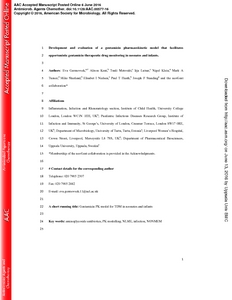Germovsek, E;
Kent, A;
Metsvaht, T;
Lutsar, I;
Klein, N;
Turner, MA;
Sharland, M;
Nielsen, EI;
Heath, PT;
Standing, JF;
et al.
Germovsek, E; Kent, A; Metsvaht, T; Lutsar, I; Klein, N; Turner, MA; Sharland, M; Nielsen, EI; Heath, PT; Standing, JF; neoGent collaboration
(2016)
Development and evaluation of a gentamicin pharmacokinetic model that facilitates opportunistic gentamicin therapeutic drug monitoring in neonates and infants.
Antimicrobial Agents and Chemotherapy, 60 (8).
pp. 4869-4877.
ISSN 1098-6596
https://doi.org/10.1128/AAC.00577-16
SGUL Authors: Heath, Paul Trafford Sharland, Michael Roy
![[img]](https://openaccess.sgul.ac.uk/107970/1.hassmallThumbnailVersion/Antimicrob.%20Agents%20Chemother.-2016-Germovsek-AAC.00577-16.pdf)  Preview |
|
PDF
Accepted Version
Available under License ["licenses_description_publisher" not defined].
Download (1MB)
| Preview
|
Abstract
Trough gentamicin therapeutic drug monitoring (TDM) is time-consuming, disruptive to neonatal clinical care and a patient safety issue. Bayesian models could allow TDM to be performed opportunistically at the time of routine blood tests. This study aimed to develop and prospectively evaluate a new gentamicin model and a novel Bayesian computer tool (neoGent) for TDM use in neonatal intensive care. We also evaluated model performance for predicting peak concentrations and AUC(0-t). A pharmacokinetic meta-analysis was performed on pooled data from three studies (1325 concentrations from 205 patients). A 3-compartment model was used with covariates being: allometric weight scaling, postmenstrual and postnatal age, and serum creatinine. Final parameter estimates (standard error) were: clearance: 6.2 (0.3) L/h/70kg; central volume (V) 26.5 (0.6) L/70kg; inter-compartmental disposition: Q=2.2 (0.3) L/h/70kg, V2=21.2 (1.5) L/70kg, Q2=0.3 (0.05) L/h/70kg, V3=148 (52.0) L/70kg. The model's ability to predict trough concentrations from an opportunistic sample was evaluated in a prospective observational cohort study that included data from 163 patients with 483 concentrations collected in five hospitals. Unbiased trough predictions were obtained: median (95% confidence interval (CI)) prediction error was 0.0004 (-1.07, 0.84) mg/L. Results also showed peaks and AUC(0-t) could be predicted (from one randomly selected sample) with little bias but relative imprecision with median (95% CI) prediction error being 0.16 (-4.76, 5.01) mg/L and 10.8 (-24.9, 62.2) mg h/L, respectively. NeoGent was implemented in R/NONMEM, and in the freely available TDMx software.
Statistics
Item downloaded times since 20 Jul 2016.
Actions (login required)
 |
Edit Item |



